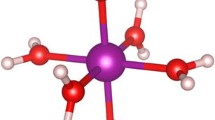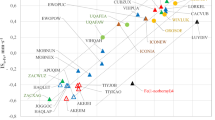Abstract
The Ewald method has been used to calculate the effect of electrostatic environments (crystal lattices) on the molecular orbitals and spectroscopic state levels of the oxyanions, permanganate and chromate. An estimate of factor group splitting based on a crude model suggests that it may be an observable effect in molecular ions in crystals. However the shifts in energy and the splitting of bands due to electrostatic effect of the lattice are predicted to be more important than the factor group splittings. Attention is drawn to the significant effect of the lattice field on the molecular orbital energies, making the uppermost filled orbital of the ground state strongly bonding, in contrast to the situation in the isolated anions.
Zusammenfassung
Nach dem Verfahren von Ewald wurde der Einfluß des elektrostatischen Beitrages des Kristallgitters auf die MO's und spektroskopische Zustände des Permanganat- und Chromat-Anions berechnet. Eine rohe Abschätzung der Faktorgruppen-Aufspaltung legt die Vermutung nahe, daß auch dieser Effekt beobachtbar ist. Jedoch sind die Energieverschiebungen und Aufspaltungen infolge der Umgebung des Kristallgitters wahrscheinlich größer als die Faktorgruppen-Aufspaltung. Es wird besonders auf den bedeutenden Einfluß des Gitterfeldes auf die MO-Energien hingewiesen, die das oberste besetzte Orbital des Grundzustandes stark bindend machen, ganz im Gegensatz zur Situation für die isolierten Anionen.
Résumé
La méthode d'Ewald a été utilisée pour calculer l'effet de l'environnement électrostatique (réseaux cristallins) sur les orbitales moléculaires et les états spectroscopiques des oxyanions permanganate et chromate. L'estimation de la séparation du groupe facteur sur la base d'un modèle grossier suggère que cet effet peut être observé dans les ions moléculaires dans les cristaux. Cependant les déplacements et les séparations des bandes dûs à l'effet électrostatique du réseau sont prédits comme étant plus grands que les séparations du groupe facteur. On attire l'attention sur l'effet significatif du champ du réseau sur les énergies des orbitales moléculaires, la plus haute orbitale occupée devenant fortement liante, contrairement à ce qui a lieu dans les anions isolés.
Similar content being viewed by others
References
Brown, R. D., James, B. H., O'Dwyer, M. F.: Theoret. chim. Acta (Berl.) (in press).
- - McQuade, T. J. V., O'Dwyer, M. F.: Theoret. chim. Acta (Berl.) (in press).
- - O'Dwyer, M. F.: Theoret. chim. Acta (Berl.) (in press).
—, O'Dwyer, M. F., Roby, K. R.: Theoret. chim. Acta (Berl.) 11, 1 (1968).
Palernik, G. J.: Inorg. Chem. 6, 503 (1967).
Zachariasen, W. H., Ziegler, G. E.: Z. Kristallogr. 80, 164 (1931).
Miller, J. J.: Kristallogr. A 99, 32 (1938).
International Tables for X-Ray Crystallography. Birmingham: Kynoch Press 1952.
Ewald, P. P.: Ann. Physik 64, 253 (1921).
Slater, J. C., DeCicco, P.: Quart. Prog. Report, M.I.T. 50, 46 (1963).
Craig, D. P., Walmsley, S. H.: Physics and chemistry of the organic solid state, ed. by Fox, D., Labes, M. M., Weissberger, A., New York: Wiley 1963.
Fox, D., Schnepp, O.: J. chem. Physics 23, 767 (1955).
Bernstein, E. R., Colson, S. D., Kopelman, R., Robinson, G. W.: J. chem. Physics 48, 5596 (1968).
Hirschfelder, J. O., Curtiss, C. F., Bird, R. B.: Molecular theory of gases and liquids. New York: John Wiley 1954.
Narishma Rao, D.V. A. H., Marasimhamurty, A.: Physic. Rev. 132, 961 (1963).
Coogan, C. K.: Austral. J. Chem. 20, 2551 (1967).
Thirunamachandran, T., reprinted by Craig, D. P., Walmsley, S. H.: Physics and chemistry of the organic solid state I. New York: Wiley 1963.
Kornfeld, H.: Z. Physik 22, 27 (1924).
den Boef, G., van der Beek, H. J., Braaf, T.: Rec. Trav. chim. Pays-Bas 77 1064 (1958).
Von Halben, H., Litmanowitsch, M.: Helv. chim. Acta 24, 44 (1941).
Holt, S. L., Ballhausen, C. J.: Theoret. chim. Acta (Berl.) 7, 313 (1967).
Teltow, J.: Z. Physik. Chem. (Leipzig) B 43, 198, 375 (1939) and B 40 397 (1938).
Mani, N. V.: Proc. Indian Acad. Sci. A 46, 143 (1957).
Dahl, J. P., Ballhausen, C. J.: Advances quant. Chem. 4, 170 (1968).
Author information
Authors and Affiliations
Rights and permissions
About this article
Cite this article
Brown, R.D., James, B.H. & O'Dwyer, M.F. Molecular orbital calculations on transition element compounds. Theoret. Chim. Acta 19, 45–54 (1970). https://doi.org/10.1007/BF00527376
Received:
Issue Date:
DOI: https://doi.org/10.1007/BF00527376




